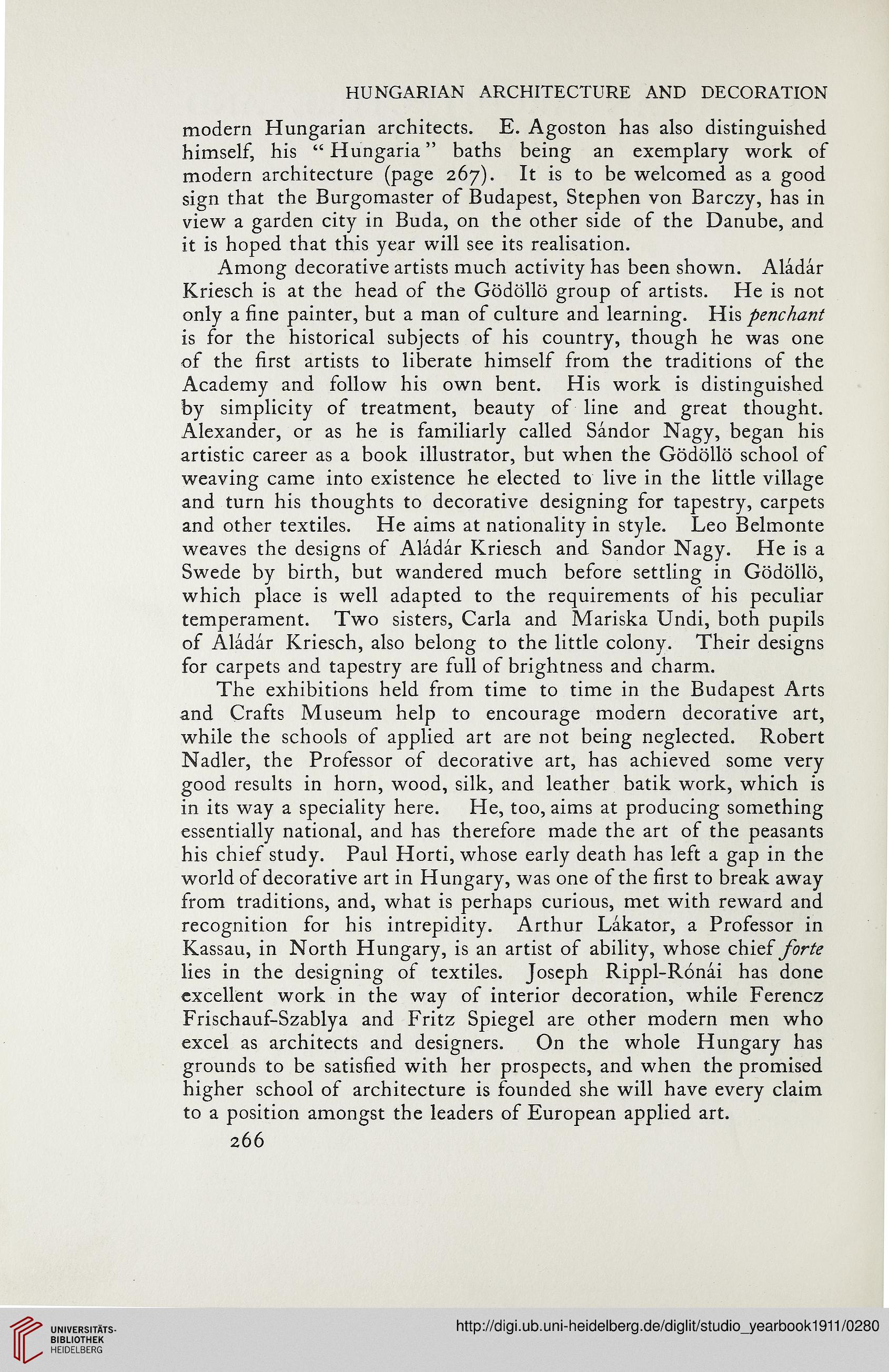HUNGARIAN ARCHITECTURE AND DECORATION
modern Hungarian architects. E. Agoston has also distinguished
himself, his “Hungaria” baths being an exemplary work of
modern architecture (page 267). It is to be welcomed as a good
sign that the Burgomaster of Budapest, Stephen von Barczy, has in
view a garden city in Buda, on the other side of the Danube, and
it is hoped that this year will see its realisation.
Among decorative artists much activity has been shown. Aladar
Kriesch is at the head of the Godollo group of artists. He is not
only a fine painter, but a man of culture and learning. His penchant
is for the historical subjects of his country, though he was one
of the first artists to liberate himself from the traditions of the
Academy and follow his own bent. His work is distinguished
by simplicity of treatment, beauty of line and great thought.
Alexander, or as he is familiarly called Sandor Nagy, began his
artistic career as a book illustrator, but when the Godollo school of
weaving came into existence he elected to live in the little village
and turn his thoughts to decorative designing for tapestry, carpets
and other textiles. He aims at nationality in style. Leo Belmonte
weaves the designs of Aladar Kriesch and Sandor Nagy. He is a
Swede by birth, but wandered much before settling in Godollo,
which place is well adapted to the requirements of his peculiar
temperament. Two sisters, Carla and Mariska Undi, both pupils
of Aladar Kriesch, also belong to the little colony. Their designs
for carpets and tapestry are full of brightness and charm.
The exhibitions held from time to time in the Budapest Arts
and Crafts Museum help to encourage modern decorative art,
while the schools of applied art are not being neglected. Robert
Nadler, the Professor of decorative art, has achieved some very
good results in horn, wood, silk, and leather batik work, which is
in its way a speciality here. He, too, aims at producing something
essentially national, and has therefore made the art of the peasants
his chief study. Paul Horti, whose early death has left a gap in the
world of decorative art in Hungary, was one of the first to break away
from traditions, and, what is perhaps curious, met with reward and
recognition for his intrepidity. Arthur Lakator, a Professor in
Kassau, in North Hungary, is an artist of ability, whose chief forte
lies in the designing of textiles. Joseph Rippl-Ronai has done
excellent work in the way of interior decoration, while Ferencz
Frischauf-Szablya and Fritz Spiegel are other modern men who
excel as architects and designers. On the whole Hungary has
grounds to be satisfied with her prospects, and when the promised
higher school of architecture is founded she will have every claim
to a position amongst the leaders of European applied art.
266
modern Hungarian architects. E. Agoston has also distinguished
himself, his “Hungaria” baths being an exemplary work of
modern architecture (page 267). It is to be welcomed as a good
sign that the Burgomaster of Budapest, Stephen von Barczy, has in
view a garden city in Buda, on the other side of the Danube, and
it is hoped that this year will see its realisation.
Among decorative artists much activity has been shown. Aladar
Kriesch is at the head of the Godollo group of artists. He is not
only a fine painter, but a man of culture and learning. His penchant
is for the historical subjects of his country, though he was one
of the first artists to liberate himself from the traditions of the
Academy and follow his own bent. His work is distinguished
by simplicity of treatment, beauty of line and great thought.
Alexander, or as he is familiarly called Sandor Nagy, began his
artistic career as a book illustrator, but when the Godollo school of
weaving came into existence he elected to live in the little village
and turn his thoughts to decorative designing for tapestry, carpets
and other textiles. He aims at nationality in style. Leo Belmonte
weaves the designs of Aladar Kriesch and Sandor Nagy. He is a
Swede by birth, but wandered much before settling in Godollo,
which place is well adapted to the requirements of his peculiar
temperament. Two sisters, Carla and Mariska Undi, both pupils
of Aladar Kriesch, also belong to the little colony. Their designs
for carpets and tapestry are full of brightness and charm.
The exhibitions held from time to time in the Budapest Arts
and Crafts Museum help to encourage modern decorative art,
while the schools of applied art are not being neglected. Robert
Nadler, the Professor of decorative art, has achieved some very
good results in horn, wood, silk, and leather batik work, which is
in its way a speciality here. He, too, aims at producing something
essentially national, and has therefore made the art of the peasants
his chief study. Paul Horti, whose early death has left a gap in the
world of decorative art in Hungary, was one of the first to break away
from traditions, and, what is perhaps curious, met with reward and
recognition for his intrepidity. Arthur Lakator, a Professor in
Kassau, in North Hungary, is an artist of ability, whose chief forte
lies in the designing of textiles. Joseph Rippl-Ronai has done
excellent work in the way of interior decoration, while Ferencz
Frischauf-Szablya and Fritz Spiegel are other modern men who
excel as architects and designers. On the whole Hungary has
grounds to be satisfied with her prospects, and when the promised
higher school of architecture is founded she will have every claim
to a position amongst the leaders of European applied art.
266




